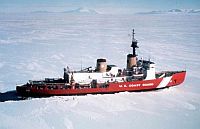
USCG Polar Star
Paradoxically, the decreasing polar ice cap has increased the need for icebreakers. As the ice diminishes, traffic has increased above the Arctic Circle, making the need for icebreaking to assist in transit or respond to emergencies ever more important. On his recent trip to Alaska, President Obama called for building new icebreakers to meet that need. The Coast Guard determined that it needs three heavy and three medium icebreakers to cover the U.S. anticipated needs in the Arctic and Antarctic.
Currently the US has only one heavy icebreaker, USCG Polar Star, and one medium icebreaker, USCG Healy, in service. In comparison, Russia has a fleet of 32 polar icebreakers. Finland has eight, Sweden has seven and Canada has six.
A second heavy icebreaker, USCG Polar Sea broke down in 2010 and was decommissioned by the Coast Guard. Both ships first went into service in 1976. Things have actually improved somewhat. For several years, the US only had one large icebreaker in service, the Healy, until the Polar Star was refurbished and put back into service in 2013.
The largest problem seems to be how to fund the new icebreakers. The US Coast Guard is chronically underfunded and the heavy icebreakers are expected to cost roughly one billion dollars each.
It seems to be a matter of priorities. While the US has few icebreakers, it has quite a few aircraft carriers. Indeed, as measured by flight deck acreage, the US has more than twice the air craft carrier capacity of all the navies in the world combined. Most navies of the world have at most one aircraft carrier. The US has ten Nimitz class “supercarriers” and nine LHAs and LHD flat-tops. The rest of the world’s navies combined have only 12 carriers, most of which are significantly smaller than the American supercarriers.
Nevertheless, the Navy is building a new class of aircraft carrier. The first, the USS Gerald R. Ford, is expected to cost $13 billion by the time it is delivered in February 2016. Even as the most expensive ship ever built by the Navy, the new carrier is reported to be still plagued by significant problems. The Navy plans to spend $40 million or so on the first three ships of the series. The plan is to build ten of the Ford class ships to replace the existing ten Nimitz class aircraft carriers.
As compared to the seemingly unlimited amounts of money being spent by the Navy, the $3 billion needed by the US Coast Guard seems relatively paltry. Indeed, the cost overrun on the Gerald R. Ford alone, would fund the entire icebreaker building program. Given the immediate need for icebreakers, the claim that the US may lack the funds to build them, seems suspect. Perhaps shifting a comparatively few dollars from the Navy’s budget to the Coast Guard would be a very good idea. The US currently needs new icebreakers more than it needs new carriers.

yep easy choice, icebreakers first!
More Ice Breakers to keep the shipping channels open for more Hydrocarbon fuel cargos to create even more global warming, and climate change!
-Makes sense to me!
WS, even if we were using sailing ships to move cargo, it wouldn’t change the fact that we need icebreakers to manage ship traffic in the Arctic. The facts are these; Congress both under Democratic and Republican control, has ignored the needs of the USCG to modernize their fleet, to the point where they are endangering both mariners and the environment. It’s time for Congress and America to recognize that maritime security begins at home.
The CVN-78 is equivalent to 140,000,000 Aquarium tank heaters:
Run Ten of these 24/7, and you won’t need any icebreakers!